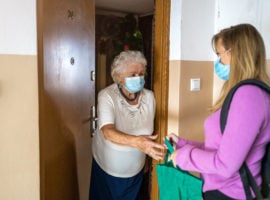This article is based on opinions from staff at food banks around the country. If you have comments or questions, please email us at [email protected]
It is a traumatizing situation as a young child to be without food. You see the fear in the faces of your mother and father, despairing that they cannot feed their children. You feel afraid, too, because your parents can’t provide for you.
—Peter Kimeu, “Remembering a Hungry Childhood,” New York Times, 9/10/11
Backpack programs seem like a great thing on the surface. Most of them serve the youngest, most at-risk kids. And of course that makes everybody feel good because who is more deserving than kids? Who can beat those smiling faces when you hand them a bag of food? But there are a number of things to consider when designing a backpack program.

• Because they generally only target one child in a household, they may be setting that child up to be the only child or family member with food for the weekend. The recipient may be set up for abuse by an older sibling or parent who will take the food or they may just feel guilty for having been chosen to be the one who is fed.
• Depending on where the programs are located, someone has to decide who the most deserving children are. Once they have been chosen, then they will be singled out to receive a bag of food at the end of the school week. This can easily set them up to be a target of ridicule by their classmates.
• The act of giving kids food to take home changes the family dynamic and usurps a parent’s role of being the provider. An emergency food box is usually acquired by a parent. Meals eaten at school, a youth program or a summer food site do not have the same effect.
• Because of the need to use primarily non-perishable foods, the products are not always the most nutritious. They often include microwaveable entrees sent home with kids too young to use the microwave and who may not even have a microwave available. When perishable products are provided, they may not be handled safely and could become a health risk.
• The products provided are not easily acquired through many food bank networks and may need to be purchased. The type of products distributed (individual cereals and entrees, aseptic milk, juice, etc.) are expensive, making backpacks a more costly hunger assistance program and threatening the sustainability of such programs. The programs are difficult to evaluate. Backpack programs report a low rate of return on evaluations and seldom get constructive feedback. The kids receiving the food are not good evaluators and are unlikely to report what really happens to the food. A parent is seldom going to critique any program that is feeding a child in need.

Are these good enough reasons to not do the program? That is something for each group to decide. Feeding little children is a very seductive thing. Consider some alternatives. One such program distributes bags of supplemental food to families every two weeks. The bag contains 10-15 pounds of food that can be eaten by the whole family and is given to the parent at the bus stop or when a child is picked up. For example, a bag may contain a jar of peanut butter or block of cheese, bread, granola bars, fresh produce, etc. There are ways to make sure that children are fed without compromising them or their family dynamic. It just takes a little creativity.





